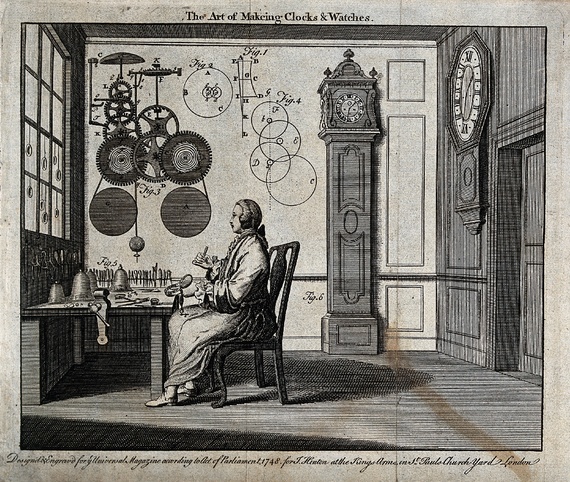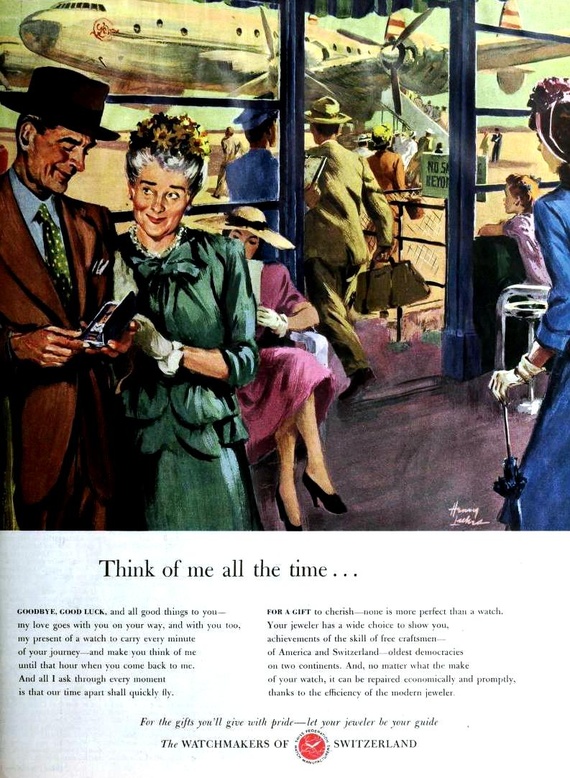The watchmaker analogy seems timeless—antiquated, yet always in fashion. The most famous version comes from the English clergyman William Paley’s 1802 book Natural Theology. Just as a watch is made up of several different pieces, “framed and put together for a purpose,” he reasoned, so too are natural objects—eyes, ears, wings, and bones—made up of parts that combine to serve a higher function. As the watch is the design of a watchmaker, nature is the product of a designing intelligence, or God.
The analogy has had generations of supporters and critics. Richard Dawkins borrowed from Paley for the title of his 1986 book The Blind Watchmaker, which attacked the idea that complex life needed a religious explanation. Michael Behe, the biochemist who helped launch the modern intelligent design movement with his 1996 book Darwin’s Black Box, embraced Paley and his watchmaker, while maintaining that the argument for design was scientific, not religious. People involved in today’s debates over evolution and design clearly have different interpretations of how the watchmaker argument works, but they agree that it still matters. In the 2004 Kitzmiller v. Dover trial, where a Pennsylvania school district was sued for presenting intelligent design to students, Paley’s watchmaker was invoked by expert witnesses for both sides to explain the state of antievolutionism in the 21st century.
But does “watchmaker” really say God to us in the digital age? If we want to understand God through a technological metaphor, wouldn’t the computer programmer, the genetic engineer, or the environmental scientist seem more apt? With accurate clocks built into our cellphones, computers, coffeemakers, and cars, a device whose main purpose is to tell the time seems quaint—an eccentric luxury, not the work of awe-inspiring genius.
One’s choice of technology might have little consequence for design arguments’ logic, but each evokes a different image of divine power. Design arguments have never been intended to prove the mere existence of God, they’ve always been used to tell us something about the kind of God who designed us. The metaphors that help people understand God are reflections of the kind of God they desire, whether it’s one who works mysteriously, one who cares about human welfare, or one who rewards some people and punishes others. It's hard to imagine what we could say today about a God who is like a watchmaker. If we own watches, we might realize that someone made them, but who that person is and what they do is largely an abstraction today.
Paley was not the first to compare God to a watchmaker, but he did so in a more nuanced way than those who preceded him. And he wrote at a precise moment in the history of watch- and clock-making: when the world’s best watches were made in England, and watchmaking was an essential technology in modern society. When Paley began his book by considering a watch, he wasn’t just choosing the most complicated piece of technology at hand, and he didn’t want to just prove the existence of some generic designer; he was arguing for a specific interpretation of the Christian God, one who smiled upon British industry and imperialism.
* * *

Perhaps the most important thing to know about English “watchmakers” in the 18th and early 19th centuries is that they rarely spent any time making watches.
As early as 1729, Bernard Mandeville wrote that “Watch-making… is come to a higher degree of Perfection, than it would have arrived at yet, if the whole had always remain’d the Employment of one Person.” Different parts were made in separate workshops and factories around the country. Mandeville inspired Adam Smith, who used watchmaking to describe how the division of labor led to more efficient production in his 1776 Wealth of Nations. By 1819, Abraham Rees’s Cyclopedia listed 13 different “principal workmen employed in manufacturing a movement” and 21 additional “workmen employed on a watch to complete it from the state in which the movement is received from the country.” None of these workmen were “watchmakers”; that title was reserved for the masters who were responsible for overseeing the final assembly and arrangement of these components. As Robert Campbell described in 1747:
The Watch-Maker puts his Name upon the Plate, and is esteemed the Maker, though he has not made in his shop the smallest Wheel belonging to it. It is supposed, however, that he can make all the Movements… He must be a Judge of the Goodness of Work at first Sight, and put his Name to nothing but what will stand the severest Trial; for the Price of the Watch depends upon the Reputation of the Maker only.
This was the watchmaker-God who Paley proposed: an assembler, an overseer, a judge. One who has the power and knowledge to make every component personally, but actually delegates some work of creation to “the ministry of subordinate agents.” Paley argued, “it is as though one Being should have fixed certain rules; and, if we may so speak, provided certain materials,” and left the task of creating the complex parts of living things to the appointed agency of natural laws. The watchmaker is not alone in his workshop, meticulously filing each gear and chain link and polishing each crystal; nor is the watchmaker God personally crafting the eyes of each animal, nor shaping their wings or eardrums. It is a managerial God, with important business to run and with a reputation for good products.
* * *
The task of upholding that reputation included preventing fraud. The watchmaker “put his Name upon the Plate,” but he also ensured that his name was not used on inferior goods. Counterfeit watches were a huge problem in 18th-century England. They were typically cheaper, less accurate mechanisms that were made in Geneva, smuggled across France, and falsely marked with London names. The Worshipful Company of Clockmakers, the guild of clock and watchmakers established in London in 1631, led the fight against the invasion of these Swiss knockoffs.
The English watchmaker was cloaked in patriotism, defending the homeland against the foreign corruption of inaccurate timekeeping. He was also the enabler of British naval strength and global domination. In the 18th century, with European powers scrambling to establish dominion in the New World and explore new routes around the globe, one of the great challenges was navigation and the determination of longitude. Figuring out how far East or West one was was a great technical challenge, that could cause a ship to run aground, fall afoul of pirates, or simply get lost. Mechanical clocks would quickly lose track of time, distorted by the effects of weather and ships’ motion on their workings. Astronomical navigation using the stars that appeared to move as the earth rotated also proved problematic. In 1714, the British government instituted a prize for the best solutions to the longitude problem. Many people contributed innovations through the next few decades, improving techniques in both timekeeping and celestial navigation. A half century after the prize was announced, the problem was considered solved by John Harrison, who built marine chronometers that could manage a sea voyage of several months without losing significant track of time.
In the Natural Theology, Paley acknowledged that Harrison’s “contrivance for making a watch regulate itself… by the artful use of the different expansion of metals… has been justly praised.” Paley not only recognized the ingenuity of Harrison’s invention, he also understood its real importance. Timekeeping was a national priority because longitude was a matter of military and economic security. The watchmaker was not only an intelligent designer, but his work enabled the British to thrive and surpass Continental competitors.
The watchmaker not only served Britannia by defending against invasive technological piracy, he also fought against piracy on the high seas, and had ensured the supremacy of the British navy by his inventions. Paley’s God was also like a watchmaker in sharing those priorities. Writing as chaos raged in France and sympathizers rallied for a revolution at home, Paley argued that the successful functioning of a well-regulated society on the English side of the Channel was evidence that Britain was acting in accordance with God’s plan, and continuing to do so would lead to prosperity.
Perhaps nothing demonstrated successful British society as much as watchmaking itself. Parts were made in cities all over the country, so well specified that when they were brought together for assembly, they would fit and work. For the industry to function this way required the coordination of moving parts more complicated than any watch. From this perspective, the watchmaker argument wasn’t just an analogy, it was an example. A society where watches were so ubiquitous and well made that readers could understand the watchmaker analogy was one that was itself well-coordinated. That society's parts, the economic and technological infrastructure that allowed watch parts to circulate and the human components well adapted to capitalist, nationalist, and industrial purposes, were so well put together that it must also be the work of a social designer. The watchmaker argument was a kind of proof in itself. A society that could understand watches well enough to understand how the analogy works is a society whose function must have been ordered by God.
* * *
The watchmaker God was a God of the establishment, both in the sense of supporting the state established Church of England, and in the sense of opposition to radical or revolutionary change. Yet social changes came in the decades after Paley’s death and along with it came changes to watchmaking. As industrialism manufacturing spread in the early 19th century, watchmaking was no longer the most innovative use of specialized labor in Britain. In fact, some economic historians blame the watch industry’s failure to innovate for its eventual demise. Swiss watchmakers developed thinner, lighter, and cheaper watches, which (despite being less accurate) were in great demand from those who saw such items as fashionable symbols of middle-class respectability. Smuggling problems grew even worse. In 1831, French customs officers reported that smugglers would take packs of large dogs across the border into Switzerland or Belgium, attach bundles of watches to them, and then let them loose to run back to their masters’ homes carrying their untaxed cargo. These chiens fraudeurs—frauding dogs—were almost impossible to catch. Border agents reported that the dogs had learned to recognize their uniforms and either flee away from the roads or else attack them. By the 1840s, the English industry had been almost entirely surpassed by the Swiss.

The idea of God is so abstract, so vast, and so incomprehensible, that it may only be possible to think about it in metaphors. But the meanings that people draw from those metaphors evolve as the objects of analogy lose their significance. God as Father takes on new meanings in a society self-conscious about or critical of patriarchy. Those who think of God as a King probably aren't thinking of the modern constitutional monarchies of Europe. And God as a watchmaker has changed too. While the meaning of metaphors change, what remains true is the fact that we can make meaning from them. The modern versions of watchmaker arguments aren’t merely logical deductions of a generic God any more than Paley’s argument was. We might want to look more carefully at the metaphors used today to better understand just what kind of God is being proposed in the argument for “design.”
We’ve gone from the watchmaker as divine protector of the realm to a world, as Douglas Adams quipped, “whose ape-descended life forms are so amazingly primitive that they still think digital watches are a pretty neat idea.” From watches as evidence of God to watches as objects of fascination for the evolving yet primitive human being, this is a technology that continues to evoke an emotional and complex response, just not a timeless one.
This article was originally published at http://www.theatlantic.com/technology/archive/2015/02/god-watchmakers-and-the-short-half-lfe-of-technology-metaphors/385408/
